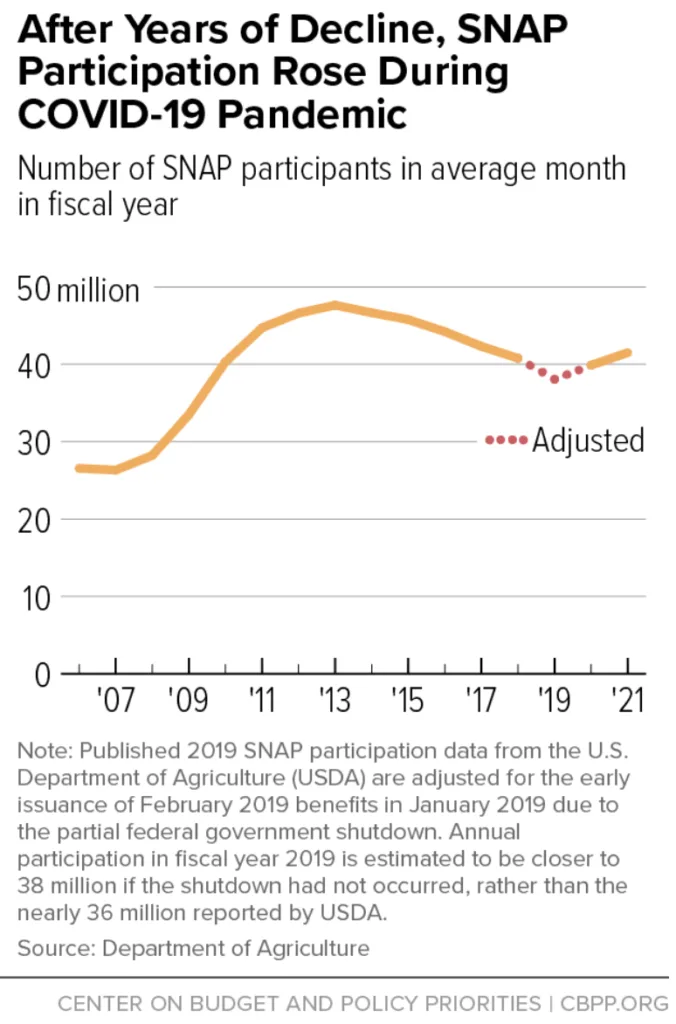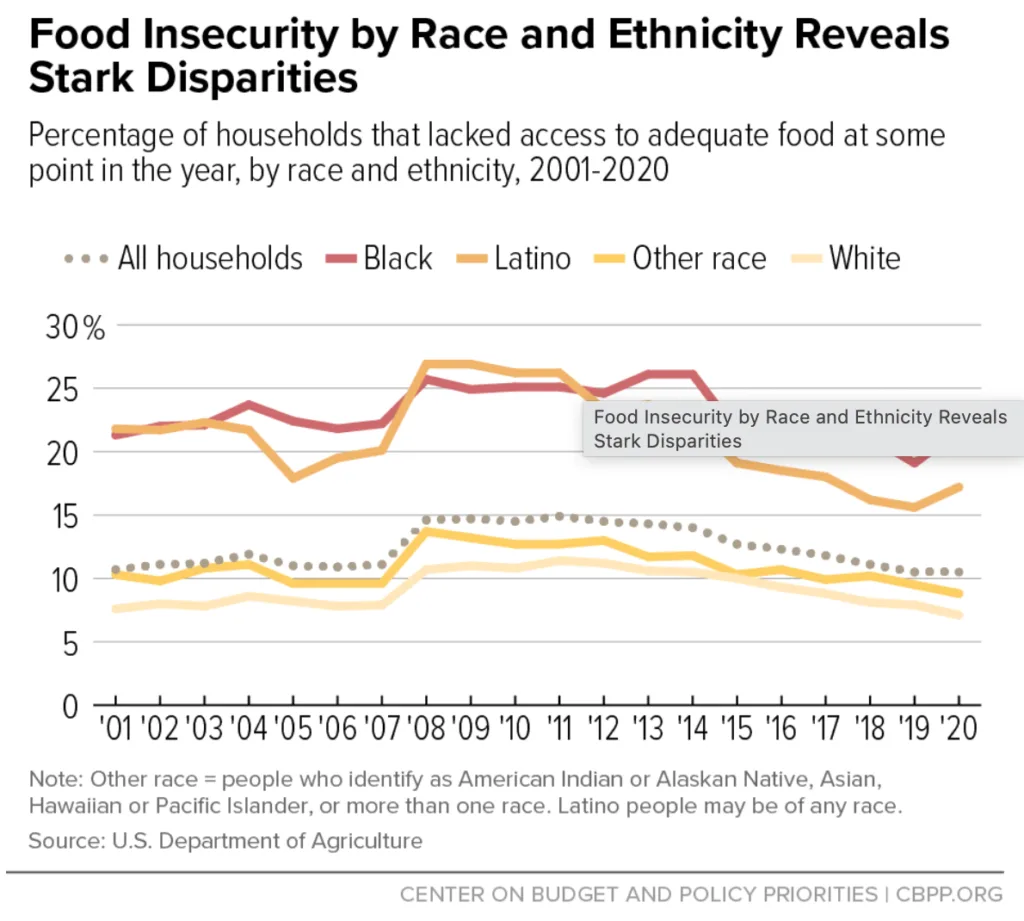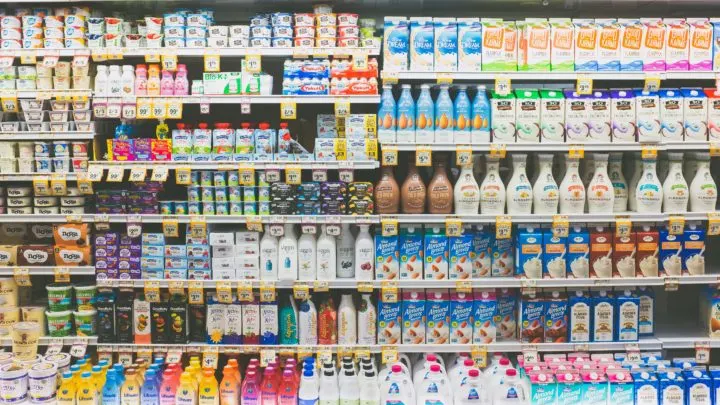Though previously officially known as Food Stamps, the Supplemental Nutrition Assistance Program (SNAP) provides millions of hungry Americans with necessary food and nutrition. During 2021, the federal government spent about $111 billion on SNAP and other food assistance programs. Yet, many critics of the program argue that it doesn’t do enough to help hungry families, or provide them with the adequate nutrition they need. Keep reading so you can decide for yourself whether or not food stamps really help.
Who in the United States suffers from hunger?
According to the USDA, more than 38 million people in the United States suffer from hunger. This includes more than 12 million children.
However, food insecurity impacts certain communities more than others.
For instance, rural communities experience hunger at higher rates than those living in urban or suburban areas. More specifically, rural towns make up 63 percent of the counties in the United States, but represent 91 percent of the counties with the highest rates of food insecurity. In addition to this:
- 2.1 million households in rural areas experience hunger
- 86 percent of counties with the highest rates of hunger are in rural areas
- 13.3 percent of people live in poverty in rural areas, compared to only 10 percent of people in urban areas
- Black people living in rural areas are 2.5 times more likely to experience hunger compared to white people living in urban areas
Other household demographics also help determine which American households face hunger. For example, food insecurity was more common among the following demographics:
- Households with children with a single mother (8.2 percent of these households experience hunger)
- Women living by themselves (5.1 percent of these households experience hunger)
- Men living by themselves (5.7 percent of these households experience hunger)
- Households with an income below 185 percent of the federal poverty line (10.8 percent of these households experience hunger)
Since the COVID-19 Pandemic, hunger in the United States has increased, leading to SNAP participation to subsequently increase.

Who is eligible for food stamps?
To qualify for SNAP, participants must meet one of the three categories:
- Their gross monthly income must be at or below 130 percent of the federal poverty line.
- Their net monthly income, after housing, childcare, and related costs, must reach the poverty line.
- Their household assets fall below a pre-determined limit, specific to the fiscal year.
However, there are limits to this eligibility. For instance, non-disabled adults can only receive up to 3 months of benefits, if they are not working at least 20 hours a week or participating in a job training program.
Despite these limitations, there are multiple ways that Americans may qualify for SNAP, which allows millions to gain access to the program. However, this begs the question, who is actually taking advantage of SNAP, and is this subsidized plan enough?
Who actually receives food stamps?
Approximately two-thirds of SNAP recipients are families with children. Further, about one-third of SNAP recipients are either older adults or individuals with disabilities.
SNAP recipients include people of various races and ethnicities:
- 37 percent of recipients are White
- 26 percent of recipients are Black
- 16 percent of recipients are Hispanic
- 3 percent of recipients are Asian
- 2 percent of recipients are Native American
- 16 percent of recipients are categorized as “race unknown”

Does SNAP actually cover the cost of a meal?
According to the Urban Institute, in 2020, SNAP benefits did not cover a “moderately priced meal” in about 96 percent of counties in the US.
In response to this highly unaffordable rate, SNAP instituted a new plan, called the Thrifty Food Plan. This initiative successfully increased the maximum SNAP benefit by 21 percent, to allow participants to be able to purchase more food.
Still, only about 36 percent of SNAP recipients receive the maximum allotment allowed by the program. This means that the remaining 64 percent of SNAP recipients have to spend a portion of their other income on food. This means that most SNAP recipients have a harder time making it through the month without hunger, they might be forfeiting nutrition quality, or making trade-offs on health or other important basic needs.
Does SNAP change health outcomes?
According to the Center on Budget and Policy Priorities, SNAP is positively associated with improved long-term health outcomes.
This is because when using SNAP, families are less likely to sacrifice healthcare and other basic needs, since they know they will have enough food. When families are able to put food on the table, they are less likely to make detrimental health trade-offs.
Does SNAP create revenue and jobs?
According to the USDA, $1 billion additional funds allocated to SNAP food stamps would lead to:
- Generating $32 million in revenue for American agriculture businesses
- Supporting 13,560 existing jobs in agriculture
- Creating 480 additional agriculture jobs around the country
- $1.54 billion increase in Gross Domestic Product (GDP)
- Creating 1,540 jobs in manufacturing, including food, beverage, and packaging companies
Does SNAP reduce poverty while feeding the country’s hungriest?
According to the Food Research & Action Center, more than 9 percent of SNAP recipients moved above the federal poverty line, after receiving food stamps.
Further, 10 percent of the lowest-earning SNAP recipients moved out of deep poverty.
Conclusion
SNAP is a a valuable resource for millions of Americans across the country. If you think you may be eligible for the program, and need help applying, be sure to click the link to get started!

